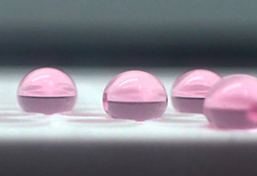Griffith University researchers have created a quicker, more effective and cost-efficient way to grow cells for use in nerve repair and other ailments by letting cells interact more naturally within ‘naked liquidmarbles’.
Using their provisionally patented naked liquid marbles method — in which a droplet of liquid on a superhydrophobic-coated plate forms a perfect ball — the scientists add cells to the liquid to more easily create cell constructs in the lab before transplanting into the body to aid nerve repair.

A still of ‘naked liquid marbles’ in the lab.
The study has been published inACS Applied Materials and Interfacesand is the edition’s Editors’ Choice.
The project was driven by PhD student, Mo Chen, with input from other PhD students and research staff from the Griffith Institute for Drug Discovery, Menzies Health Institute Queensland and the Clem Jones Centre for Neurobiology and Stem Cell Research.
The advantage of the new three-dimensional cell culture platform is that it allows cells to naturally form interactions with other cells, thereby creating more successful outcomes once in the body.
Associate Professor James St John, who heads the Clem Jones Centre for Neurobiology and Stem Cell Research and is one of the study’s leads, said other existing 3D cell culture systems forcedcells to aggregate, either through gravity or using a gel-like media in which the cells couldget stuck together.
“I like to say it’s like when you go to a party: it’s crowded and you get stuck in the corner of the room talking to people that you don’t want to talk to — you will talk to them and interact with them, but it’s not in a natural way,” A/Prof St John said.
“This new system lets the cells float around and they can meet whatever cellsthey want and form the interactions that they’d like to have. The cells do what they do in the dish as they would do in the body.
“From a nerve regeneration point of view, we can put the different cells into the naked liquidmarbleand they layer just like a nerve.Thereforewe can now grow these cell constructs to a larger size, which we’re doing in the lab, for more easily transplanting into the spinal cord.
“We can also use this system to model diseases and how they work, as well as for screening for potential new drugs.”
Associate Professor St John said their ‘naked liquid marble’ method would enhance cell survival as the cells had already formed their natural interactions as a group before being integrated into an injury site. Other technologies use individual cells, but each cell has tofight for its own survival and yields less chance of success in the body.
“What’s so great about this method is we can grow cell constructs quickly to size and with less cost, compared with other technologies that can take days longer with higher costs,” he said.
The team hopes tocommercialisethe method so that it can help other clinicians working in stem cell research that use cell transportation technologies.
